Seffarine: Healing the World Through Music.




Josefina Del Norte Reports:
Portland based but globally striding musicians Lamiae Naki and Nat Hulskamp met through mutual friends fifteen years ago. Soon after they began to collaborate musically, resulting in a song that would give rise to the Seffarine ensemble. Together they embarked on a project that would send them on an intercontinental journey, performing on stages all over the world; from the Americas, to the Iberian Peninsula, to the heart of the Western Sahara, extending humanitarian aid through music.
The fusions of the expert flamenco guitarist Nat and the deep voice of Lamiae invite us on a historical journey that spans centuries of cultural exchange from both sides of the Strait of Gibraltar. There, many cultures and beliefs coexisted for hundreds of years, as did the artistic heritage of either continent, creating a unique blend of music that still pervades the region. Influences of Spanish flamenco, Moroccan folkloric music, Andalusian music, and numerous other styles comprise the sound of Seffarine. Their musical identities are deeply rooted in age-old tradition, but the fusion continues to this day through their modern arrangements. Elements of jazz and thumping, rhythmic bass lines remind the listener of their more contemporary influences.
“We have many good musician friends in Spain and our contexts are in Spain, but on the other hand there was the intrigue of what happens in Morocco and on the other side in Africa where the desert is. And that voice was more complex, especially understanding that it is the original route of the music that we wanted to represent”
- Nat.
If there is anyone capable of sharing the complex history of the region through music, Seffarine is the group to do it, but they are equally capable of moving you to clap your hands to the rhythm of deep contemporary flamenco, accompanied on stage by dancer Manuel Gutierrez (who also plays cajón), Bobak Salehi on the spike fiddle and tar (Persian lute), and bassist Damian Erskines. The product is a transcendent experience that makes Seffarine a must-listen, especially when performing live.
In 2023 Seffarine made a fundamental trip to the heart of the Sahara, to the literal end of the road, at the edge of the the world’s largest desert.
The last Oasis M’hamid El Ghizlane is a very large cultural refuge where the cultural diversity of that region of the Sahara prevails. It’s also the primary source of local biological diversity, serving as the sole water source for many miles in any direction. It used to be the departure point for the old caravans that crossed the desert. From there all you can see is an impenetrable sea of sand dunes and one of the harshest climates on Earth. Beyond it lie some indigenous settlements, but as a result of climate change and extreme desertification, populations have been forced to migrate to the cities, losing pieces of their heritage and their music along the way. While we may not hear about climate refugees as often as we do war refugees, it is a reality that Africa faces every day. The desert is growing minute by minute, and shows no signs of stopping. People have to move because there is no water.
“[One] of the most moving and desolate images that we have in our memory is the one of the desert covering the houses with sand. The Oases are a living organism in themselves and once they die there is no turning back. Nature is so fragile and only holds in one direction.”
- Nat.
Nat and Lamiae collaborate with the Joudour Sahara Music school, started in 2016 in the Oasis, and the Playing for Change foundation, which has been helping the school for the past years. This collaboration involves a program that is responsible for protecting the cultural diversity of the Draa Valley, transmitting musical knowledge to future generations so that heritage is not lost.
Lamiae tells us how the nature of her song is derived from her diverse roots. Born in Fez, her heritage is indigenous to North and West Africa and also partially to Europe, a combination that makes total sense in the context of Seffarine’s music. When we refer to the history of the two continents we find that caravans used to traverse the borders of that region, transporting all types of food, art, population and experience. They formed new social networks in the search of better living conditions. Through this process of cultural mixing and diaspora, it was essential that history moved with the people wherever they went. The African heritage that crossed the Strait of Gibraltar for centuries mixed the song of the desert with the song of the Iberan peninsula, and that fusion still prevails through the Andalusian style.
Yet another active project Seffarine ensemble has is to help people after the devastating earthquake in Morocco in 2023, a fundraising campaign in collaboration with and by women in Marrakesh who seek to empower themselves and other women. They provide opportunities by giving women the tools to enter the workforce. They study for around eight months to earn a certificate, and from this training they gain greater independence.
Lamiae maintains that a path towards greater tolerance in the world is to teach our children languages other than their mother tongue, and to use music to create.
“Another language opens your mind, you learn about other cultures, no matter who they [are]. Music also teaches values that help understand the difference, and in that collaboration the world can build a more organic idea of peace.”
- Lamiae
The words of Lamiae ring true, and so do the dulcet stylings of the Seffarine ensemble. Their music offers a window into the world that can enrich the mind and soul of any listener. You can find out where they will show up next at Seffarine.com.



